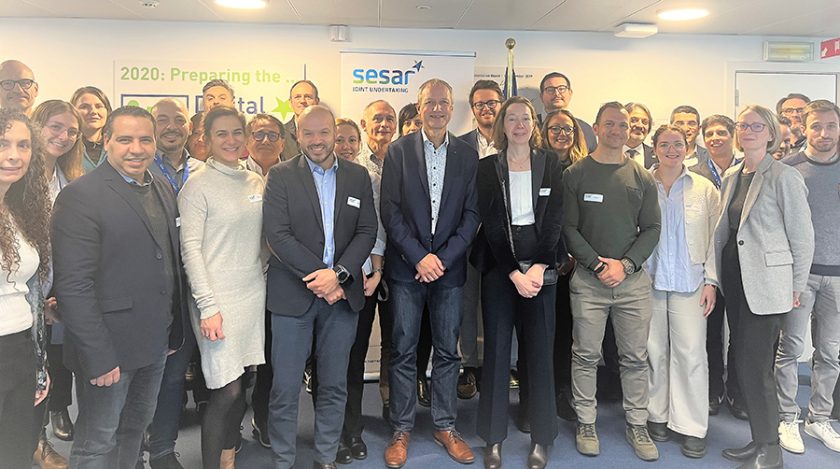U-space projects are among five new Digital Sky Demonstrators officially kicked off on 24 November. With combined funding to the tune of EUR 45 million from the Connecting Europe Facility between now and 2025, the selected projects aim to accelerate the market uptake of SESAR Solutions for greener aviation and urban air mobility (UAM).
The projects were selected following a call issued in September 2021 by the European Climate, Infrastructure and Environment Executive Agency (CINEA) under the Connecting Europe Facility. The demonstrators are a key tool to support the SESAR JUs vision of delivering the Digital European Sky, matching the ambitions of the European Green Deal and the ‘Europe fit for the digital age’ initiatives. The two SESAR-related topics covered by the call, ‘U-space and urban air mobility’ and ‘aviation Green Deal’, were selected from among nine flagships outlined in the work programme of the new SESAR 3 Joint Undertaking.
The Digital Sky Demonstrators will take place in live operational environments and will put to the test (on a very large scale) the technological solutions necessary to deliver the Digital European Sky. The demonstrators are part of an innovation pipeline designed by the SESAR Joint Undertaking to bridge the gap between applied/industrial research and industrialisation, and to accelerate market uptake. Critical to their success will be the involvement of early movers, as well as a strong and close connection with relevant standardisation and regulatory activities and bodies.
U-space and urban air mobility: To unlock the potential of the drone economy and enable urban air mobility (UAM) on a wide scale, a new air traffic management framework for low-altitude operations needs to be put in place. Known as U-space, the framework foresees a set of new services relying on a high level of digitalisation and automation of functions and specific procedures designed to support safe, efficient and secure access to airspace for large numbers of drones. As such, U-space is an enabling framework designed to facilitate any kind of routine mission, in all classes of airspace and all types of environment – even the most congested – while addressing an appropriate interface with manned aviation and air traffic control.
Project name: U-ELCOME (U-space European COMmon dEpLoyment)
Aims to facilitate the market uptake of U-space services (U1 and U2) through a set of demonstrations in various operational environments and locations across Europe (Spain, Italy and France). The demonstration activities will also address the interface with the air traffic management system to ensure safe and fair access to airspace for all airspace users.
The U-ELCOME will aim to develop a scalable U-space architecture enabling the required level of information exchange and coordination among U-space service providers (USSPs) and between USSPs and ATM using interoperable standards, allowing for automated drone traffic management and situational awareness among all U-space stakeholders.
Project name: BURDI (BeNe U-space Reference Design Implementation)
Aims to demonstrate the feasibility of managing dense and complex unmanned aircraft systems (UAS) operations in controlled, uncontrolled and urban air mobility environments. Multiple domains will be considered, such as the delivery of goods, inspections, support to medical as well as security operations. The trials will take place around the Belgian cities of Antwerp, Liège and Brussels close to international airports, an active maritime port and the border with The Netherlands. The project aims to ensure that solutions to be deployed are economically sustainable and socially acceptable and of benefit to the general public. Ultimately, the project aims to become a reference for best practices, standardisation, harmonisation and/or interoperability, fostering operational deployment of U-space airspace across Europe.
Project name: EALU-AER Enhanced Automation for U-space/ATM integration
Aims to demonstrate U-space architecture operations (U1 and U2 services) and the integration with ATM, leveraging world-class drone traffic management technology solutions. These solutions include a UAS platform (WebUAS), a backhaul network (ARINC Ground Network), communications and surveillance equipment, and advanced three-dimensional phased array radar (Skyler). The project builds on previous research and seeks to enable higher automation for future U3 and U4 services. The project will focus on five use cases of urban air mobility that capture the operational requirements, vehicle dynamics, and technology demonstrations associated with the projected near-term UAM services market, such as local inspection, light-freight, long-distance logistics, air-taxi operations, hence spanning short to long range distances.
The partners involved aim to integrate the U-space system into the Future Mobility Campus Ireland’s (FMCI) vertiport operations site and associated facilities.
For more information:




